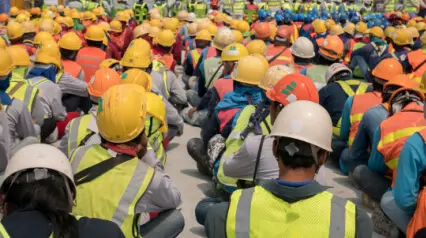What is a Working at Height Toolbox Talk?
Working at height toolbox talks are comprehensive safety meetings where team members can address safety issues, discuss the best practices for maintaining safety, and discuss all the risks that workers may face when working at heights. That way, everyone gets a full picture of the risks they face and the actions and controls in place to protect them. This helps reduce the risks and hazards when working at heights while also allowing managers to establish a culture of safety in their team.
Toolbox talks are a great way to get the team on the same page before the project starts. On top of that, it’s important to conduct them daily or weekly throughout the project, depending on your needs. That way, the team is constantly addressing safety issues and gauging how well the team performs from a safety perspective.
Why You Should Perform Regular Toolbox Talks
Toolbox talks ensure that your workers keep safety in mind when working at heights. While some projects require workers to work at heights, this is a fairly risky activity with many hazards. There are some things you can do to eliminate risks, but there are other risks that will remain constant throughout the project that the workers will have to keep in mind when working. A toolbox talk allows you to ensure that workers are aware of all the risks that they face when working and the controls in place to protect them.
Organizations have different controls, standard procedures, and Personal Protective Equipment (PPE) sets designed to protect their workers from the unique risks of the project. Toolbox talks keep all your workers on the same page and cement the importance of safety in your operations. If you’re looking to protect workers and maintain a safe work environment, regular working at height toolbox talks are essential.
Safety Hazards to Cover When Working at Heights
Working at heights is a high-risk practice. Employees are susceptible to injury or even fatality when working at heights, which is why teams need to make sure to cover all bases and major safety hazards, especially during toolbox talks.
Every project and team will face a unique set of hazards and risks. However, some of them may occur more often than other. Here are some of these risks that you need to make sure your safety team has covered:
- Adverse weather conditions
- Falling objects
- Inadequate working at heights training or experience
- Falls from heights
- Unstable or poorly maintained equipment
- Insufficient fall protection systems
Again, the risks that your workers encounter when working at heights extend further than this list. However, these are just some of the main ones that you have to prioritize during toolbox talks.
Improve your EHS Management
Cultivate a safe working environment and streamline compliance with our EHS solutions.
Explore nowHow to Conduct a Thorough Working at Height Toolbox Talk
The first step in conducting a thorough toolbox talk is understanding the risks and hazards that your workers face when working at heights. That way, you can create a list of all the topics you will have to cover during the talk and special concerns that you may need to address.
Typically, a toolbox talk starts with the manager introducing the agenda for the day. From there, they will list and identify the risks and hazards the team faces during operations. Then, the speaker will start going over the different safety procedures, policies, and protocols in place that workers must remember when working at heights.
Ideally, you should conduct these talks every time the team has to work at heights. This ensures that the information stays fresh all the time. Remember, what may seem redundant can do wonders for safety, especially when working at heights.
It’s also best to go over evacuation procedures and what to do in the event of an emergency to make sure everyone knows what to do during disasters. From there, it’s also important to ensure that you take questions from the team and allow them to talk. That way, everyone is on the same page and you fully cover all bases during the toolbox talk.




